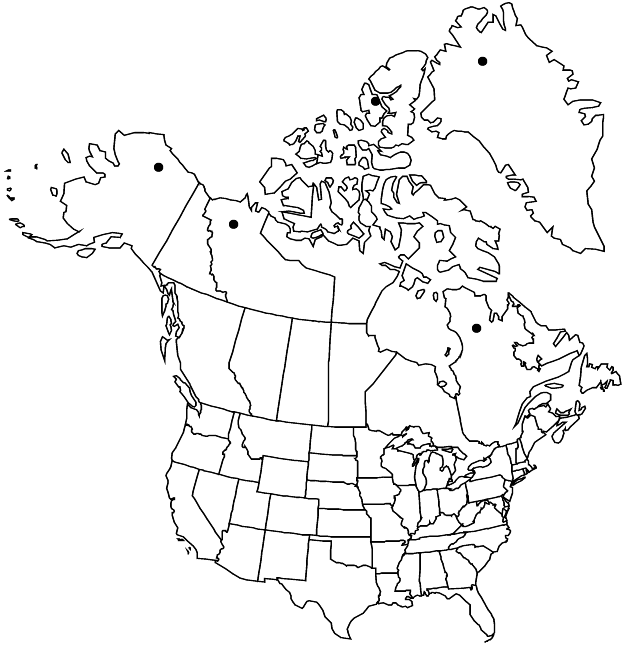Cerastium regelii
Skr. Vidensk.-Selsk. Christiana, Math.-Naturvidensk. Kl. 1909(8): 10, fig. 11. 1910.
Plants perennial, highly variable, ranging from small, pulvinate, 1–6(–8) cm, often not flowering, to rhizomatous. Stems erect or trailing, branched, pubescence confined to alternating lines of short, crispate to more elongate hairs; flowering stems erect, 1–6(–8) cm in pulvinate plants, to 20 cm in creeping plants, pubescence spreading to retrorse; nonflowering shoots creeping, elongate, 1–30 cm, with terminal, fleshy, gemmaelike buds; small axillary tufts of leaves absent. Leaves sessile; blade rotund and obovate to ovate, elliptic, or broadly lanceolate, 3–9 × 2–6 mm, succulent, apex ± acute to obtuse; proximal leaves connate at base, blades becoming marcescent, broadly and shortly spatulate, margins and midrib ciliate, glabrous to sparsely pubescent, hairs long, colorless. Inflorescences erect, lax, 1–5(–11)-flowered cymes; bracts elliptic to lanceolate, with or without narrow, scarious margins, with long, strigose hairs. Pedicels erect, usually straight, 1–10(–30) mm, shorter than sepals in pulvinate plants, longer in creeping plants, softly pubescent, hairs patent, of varying lengths, glandular and eglandular. Flowers: sepals often purple tinged, broadly elliptic, 4–6 mm, margins broad, apex round, obtuse, sparsely pubescent, hairs colorless, long, eglandular, and short, glandular; petals obovate, 4–8 mm, 1.5–2 times as long as sepals, apex deeply 2-fid; stamens 10; styles 5. Capsules cylindric, slightly curved, 6–12 mm, 1–2 times as long as sepals; teeth 10, erect to slightly spreading, margins convolute. Seeds dark brown, 1 mm diam., shallowly tuberculate; testa not inflated, tightly enclosing seed. 2n = 72.
Phenology: Flowering summer.
Habitat: High-arctic tundra to low-arctic taiga, often in wet solifluction areas or in moss
Elevation: 0-900 m
Distribution

Greenland, N.W.T., Nunavut, Que., Alaska, nw Europe (Spitsbergen), Asia (Russian Far East, Siberia).
Discussion
Until recently, Cerastium gorodkovianum (= C. jenisejense) was recognized as a species separate from C. regelii, the former being low arctic and the latter high arctic. A recent experimental study by O. M. Heide et al. (1990) elegantly demonstrated that the morphological differences are the result of the effects of day length and temperature on development. In the high arctic, C. regelii rarely flowers and is compact and pulvinate with small, broadly obovate, marcescent leaves that are fleshy, subglabrous, or with strigose cilia. In the low arctic and taiga zone, C. regelii becomes a slender, straggling plant with slender, erect inflorescences bearing a few large flowers. The creeping sterile shoots produce terminal bulbils for vegetative dispersal.
Apparent hybrids between Cerastium regelii and C. beeringianum were named C. regelii var. hirsutum Hultén. An apparent hybrid with C. arvense subsp. strictum also has been collected along the Nisling River in the Yukon.